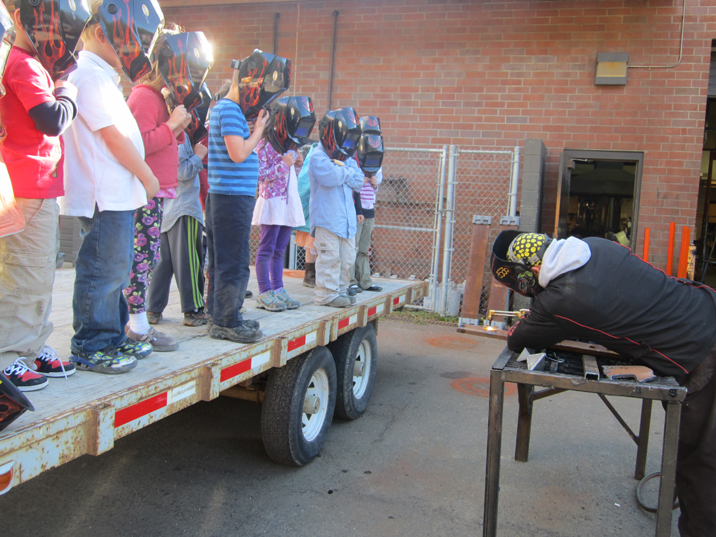On the search for more learning, the first-grade students from Paul Banks Elementary School, accompanied by teachers and four parents, tapped into the rich resource of their community Sept. 19.
Their search led to the Homer Volunteer Fire Department and, for the 16 students in teacher Wendy Todd’s classroom, to Homer High School.
“We had been studying about simple machines and push-and-pull forces,” said Todd. “This was a great way to see how this information applies to real-world applications.”
First stop was the fire hall, where the Paul Banks Peanuts were greeted by Elaine Grabowski, department services coordinator, and Chris Cushman, emergency services specialist.
“They have been so helpful in
working with us to design a program that will show the students how they would use a simple machine to help them make their work easier on a daily basis,” said Todd.
One easy example: the lever that turns on the fire hose. To make the lesson real, Grabowski invited youngsters to experience the powerful, life-saving force released by the push of the lever-type handle. With his dad, Brent, backing him up, Ethan Beard was one of the youngsters who gave it a try, sending a stream of fire-quenching water shooting across the fire department’s parking lot.
“This is a terrific program,” said Grabowski.
“(Todd) is brilliant for coming up with the idea of joining forces with the fire department since we use every simple machine concept in the work we do. We present working problems to the kids and watch them use our simple machines to solve those problems. They learn so much from the hands-on experience and have great fun, too. The teachers are wonderful to work with and we really enjoy hosting this program. It’s a win-win for everyone.”
In preparation for the Homer High visit, Todd had worked with teachers Cam Wyatt and her husband, Mickey, “to design a program that would show the students how simple machines, and not so simple machines, are used at the shop for technical jobs,” said Todd. “The high school shop also crafted the wheels for us for our cars we made to learn more about wheels and axles.”
The high school students also built an inclined plane for Todd’s students to race their cars on during the visit.
“That was a highlight,” said Todd.
Back at their own school, the first-graders wrote thank-you notes and also wrote about what they learned. Quizzes and additional hands-on science projects, such as building catapults, have helped assess and expand their understanding of simple machines.
For the past several years, Todd has been taking her students to the fire hall.
“Chris Cushman and Elaine Grabowski, with the help of their staff, have put together an excellent program for kids that supports our science unit on simple machines,” said Todd.
This year was the first time the Paul Banks Peanuts have been in Homer High Mariner territory.
“The trip to the high school was a wonderful time to build a healthy sense of community,” said Todd.
“It was amazing to see the high school students working with the younger students. It was a positive experience for all.”
The connections between the elementary-school students and the high school students hasn’t ended there.
“High school students are coming down to Paul Banks and working with reading, writing and math with the students an hour to an hour-and-a-half,” said Todd. “I have three students doing that — Aspen Daigle, Mady Gerard and Rachael Doan — and they’re doing a fabulous job.”
Todd also is working on another link with the high school, “where we will visit the biology class and learn about bones and cartilage and then go to weight-training class and learn about muscles.”
Vicki Lowe, the Homer High biology teacher, said the first-graders’ study of muscles and bones coincides with what her students are studying “because we’re just getting into the salmon unit and will take time to do some comparative anatomy. We’ll talk about local organisms, sharks versus salmon, and then look at bony skeletons preserved in the classroom.”
The muscle and bone study examines the human skeleton, a collection of small mammal skulls and a sperm whale skeleton.
Having younger students visit her high school classroom gives Lowe’s students the experience of serving as mentors and “puts on another layer of responsibility that they may not see themselves at,” she said.
For the Peanuts, there is an added bonus for the future, of “gaining a little more confidence for when they finally do get into this big building,” said Lowe.
McKibben Jackinsky can be reached at mckibben.jackinsky@homernews.com.
Dear Firefighters,
Thank you for leting us use the fire hose. I learned that a pulley can pull a prson.
From Marley
Dear Firefighters,
Thank you for shoing us the sipel msheens. I like the fire truck. It was fun. I like going their. I learned that pulley are used to pull hefee things.
Frum Preston
Dear Firefighters,
Thank you for leding me sit in the chare! I lrnd that wechis can help lift big big thanks!
From Beatrix
Dear Firefighters,
Thank you for showing us stuf.
We luv the fire hoz. We luv luv luv you.
From Henry


